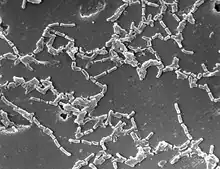Mycobacterium chelonae
| Mycobacterium chelonae | |
|---|---|
 | |
| M. chelonae as seen by scanning electron microscopy | |
| Scientific classification | |
| Kingdom: | |
| Phylum: | |
| Order: | |
| Suborder: | |
| Family: | |
| Genus: | |
| Species: | M. chelonae |
| Binomial name | |
| Mycobacterium chelonae Bergey et al. 1923, ATCC 35752 | |
Mycobacterium chelonae is a species of the phylum Actinobacteria (Gram-positive bacteria with high guanine and cytosine content, one of the dominant phyla of all bacteria), belonging to the genus Mycobacterium. Mycobacterium chelonae is a rapidly growing mycobacterium, that is found all throughout the environment including sewage and tap water. It can occasionally cause opportunistic infections of humans. It is grouped in Runyon group IV.[1]
Type strain: strain CM 6388 = ATCC 35752 = CCUG 47445 = CIP 104535 = DSM 43804 = JCM 6388 = NCTC 946.
The complete genome sequence of M. chelonae CCUG 47445 type strain was deposited and published in DNA Data Bank of Japan, European Nucleotide Archive and GenBank in 2016 under the accession number CP007220 Archived 2020-11-09 at the Wayback Machine.[2]
Epidemiology
On average, 2 cases of nonpulmonary M. chelonae infection are reported in South Australia each year.[3]
This bacteria is capable of causing skin, soft tissue and bone infections, particularly after trauma and surgery. It has been documented as a cause of breast infections after nipple piercing.
Additional images
.jpg.webp) Mycobacterium chelonae
Mycobacterium chelonae.jpg.webp) Mycobacterium chelonae
Mycobacterium chelonae.jpg.webp) Mycobacterium chelonae
Mycobacterium chelonae Mycobacterium chelonae abscesses associated with biomesotherapy, an alternative therapy practice. (The abscesses are at the biomesotherapy injection site).
Mycobacterium chelonae abscesses associated with biomesotherapy, an alternative therapy practice. (The abscesses are at the biomesotherapy injection site).
See also
References
- ↑ Mycobacterium Chelonae at eMedicine
- ↑ Jaén-Luchoro, Daniel; Salvà-Serra, Francisco; Aliaga-Lozano, Francisco; Seguí, Carolina; Busquets, Antonio; Ramírez, Antonio; Ruíz, Mikel; Gomila, Margarita; Lalucat, Jorge (2016-06-30). "Complete Genome Sequence of Mycobacterium chelonae Type Strain CCUG 47445, a Rapidly Growing Species of Nontuberculous Mycobacteria". Genome Announcements. 4 (3): e00550–16. doi:10.1128/genomeA.00550-16. ISSN 2169-8287. PMC 4901242. PMID 27284158.
- ↑ Ivan, Mihaela; Dancer, Craig; Koehler, Ann P.; Hobby, Michaela; Lease, Chris (2013). "Mycobacterium chelonae Abscesses Associated with Biomesotherapy, Australia, 2008". Emerging Infectious Diseases. 19 (9). doi:10.3201/eid1909.120898. PMC 3810901. PMID 23968779.
Further reading
- Skerman, V. B. D.; McGowan, V.; Sneath, P. H. A. (1980). "Approved Lists of Bacterial Names". International Journal of Systematic Bacteriology. 30: 225–420. doi:10.1099/00207713-30-1-225.
- Holt, John G., ed. (1994). "Table 21.3 Characteristics differentiating the rapidly growing species and subspecies of Mycobacterium". Bergey's Manual of Determinative Bacteriology (9th ed.). pp. 600–1. ISBN 978-0-683-00603-2. Archived from the original on 2016-04-15. Retrieved 2021-04-25.
- Hill, L. R.; Skerman, V. B. D.; Sneath, P. H. A. (1984). "Corrigenda to the Approved Lists of Bacterial Names: Edited for the International Committee on Systematic Bacteriology". International Journal of Systematic Bacteriology. 34 (4): 508–11. doi:10.1099/00207713-34-4-508.
- Strickland, Christopher; Jawad, Ali S.M. (2008). "Mycobacterium chelonae: a rare cause of subcutaneous nodules in a patient on long term corticosteroids". Grand Rounds. 8: 4–5. Archived from the original on 17 August 2016. Retrieved 8 August 2016.
External links
- Type strain of Mycobacterium chelonae at BacDive - the Bacterial Diversity Metadatabase Archived 2020-10-26 at the Wayback Machine